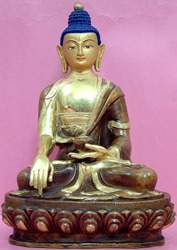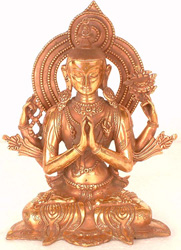
Introduction |
Geography |
History |
Communication |
Beliefs |
Society |
Economy |
Government |
Technology |
Links to Other Websites |
 |
 |
 |
Buddhism
Buddhism began in India with the birth of a prince called Siddhartha Gautama. Before he was born, his mother had a dream in which an elephant blessed her and told her that her son would be a savior to his people. Indian tradition said that a woman would travel to the home of her father so, as Mahamaya was traveling, her time came due to deliver the baby. Her servants took her into the forest for privacy and the story tells that a tree bent down its limb for her to hold onto and the baby was born from her side instead of the usual way.
There are many statues, carvings, and paintings that show this story.



Prince Siddhartha grew up in a beautiful palace and was protected from ever seeing the suffering of the outside world. He married a lovely woman and had a son. One day he happened to see an old man, someone who was diseased, and a man who had died. He was so filled with compassion for them that he left his wealthy life and chose to become a beggar and live in the world of suffering.
He meditated for many years and fasted until he almost died. One day he was sitting under a bodhi tree and reached what is called enlightenment. He had a connection with the entire universe and understood how to end the suffering of humanity. He became what is called the Buddha—the enlightened one.

Siddhartha Gautama and his family were Hindus meaning they followed the beliefs of Hinduism. They believed in reincarnation so when Siddhartha became enlightened he taught his followers how to live in this world of samsara, or suffering and impermanence. He also taught them how to get off the wheel of samsara and to reach enlightenment. Once you become fully enlightened, you no longer have to reincarnate.
There are hundreds of stories about the Buddha’s previous incarnations. They are called the Jataka stories. You will have choices at the Learning Center about what to read and then you will write summaries in your notebook. Click here for some tales now. http://www.pitt.edu/~dash/jataka.html
Buddha taught his followers many things throughout the rest of his life. His teachings can best be summarized as the Four Noble Truths and the Eight-fold Path.
Four Noble Truths Of Buddhism
-
Life is suffering;
-
Suffering is due to attachment;
-
Attachment can be overcome
-
There is a path for accomplishing this.
Eightfold Path Of Buddhism
1. Right view is the true understanding of the four noble truths.
2. Right aspiration is the true desire to free oneself from attachment, ignorance, and hatefulness.
3. Right speech involves abstaining from lying, gossiping, or hurtful talk.
4. Right action involves abstaining from hurtful behaviors, such as killing, stealing, and careless sex.
5. Right livelihood means making your living in such a way as to avoid dishonesty and hurting others, including animals.
6. Right effort is a matter of exerting oneself in regards to the content of one's mind: Bad qualities should be abandoned and prevented from arising again; Good qualities should be enacted and nurtured.
7. Right mindfulness is the focusing of one's attention on one's body, feelings, thoughts, and consciousness in such a way as to overcome craving, hatred, and ignorance.
8. Right concentration is meditating in such a way as to progressively realize a true understanding of imperfection, impermanence, and non-separateness.
There are several groups of Buddhists who differ in their practice of Buddhism but all believe in what is called the Three Jewels of Buddhism: the Buddha, the Dharma, and the Sangha. They honor or worship the Buddha and try to follow his teachings above (the Dharma) and many of them, the monks and nuns especially, live in communities called the Sangha. Even householders who do not become monks or nuns can be part of a Sangha since they are part of a community who honors and follows Buddha although they live in their own homes.
As in Hinduism, there may be confusion in Buddhist art because some of the figures look like Buddha but may be a previous incarnation or they may actually be a figure who represents an attribute or aspect of the Buddha. For example, if Buddha means enlightened one, his attribute of wisdom is often shown as the figure Manjushri and his attribute of compassion is shown as the figure Avalokiteshvara. Here are some pictures of Manjushri, Buddha, and Avalokiteshvara.
 |
 |
 |
Manjushri |
Buddha |
Avalokiteshvara |
Sometimes these beings are called bodhisattvas which are very high spiritual beings who could have reached enlightenment while on earth, but they have chosen to delay that in order to help the rest of humanity. They will become Buddhas when the last human has also achieved enlightenment. They sometimes reincarnate to help in the world, and sometimes they stay in the spiritual realms to work and pray for humanity from there.